Easily accessed from the Redwood Highway (between Cave Junction and Selma), the Eight Dollar Mountain Botanical Area and Eight Dollar Mountain Area of Critical Environmental Concern provide numerous opportunities to experience the botanically rich serpentine terrain of the Klamath-Siskiyous. But there’s even more special features as you travel through one of the most dramatic expressions of the relationship between natural plant communities and geological formations that can be found anywhere in the world. This page was last updated on 6/3/2018
A trail into one of the rarest habitats in North America
On Forest Service road 4201, the first stop after leaving private land is a wheelchair accessible boardwalk provided by the Bureau of Land Management at the Eight Dollar Mountain Area of Critical Environmental Concern. The elevated trail protects the rare plants and their habitat below and takes you to the edge of one of the rarest habitat types in North America—the serpentine Darlingtonia wetland. Beautifully illustrated Interpretive guide you along the way.
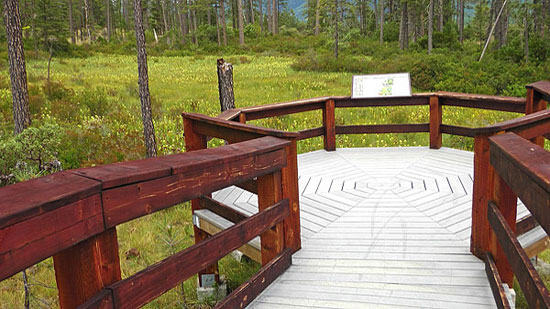
Serpentine Darlingtonia wetlands are unique and fragile groundwater dependent ecosystems
Serpentine Darlingtonia wetlands are groundwater dependent ecosystems They would not exist on the landscape without a perennial and consistent source of cool water. Without this their rare plants would die.
The groundwater system that feeds the springs these fragile and unique wetland ecosystems depend on is not well understood/. But we do know what happens when their hydrology is altered by roads, mines and off-road vehicles or even trails.
While there are Darlingtonia wetlands elsewhere, Serpentine Darlingtonia Wetlands are different and host a unique plant community. They are found only in Klamath-Siskiyou Region and the federal public lands on the west side of the Illinois River Valley have the highest concentration of these rare wetlands in the region and therefore the world.
Even though globally rare and host to plant species—some found only along a narrow strip of National Forest and BLM land, from Eight Dollar Mountain to the California border—the wetlands are being destroyed or permanently damaged by off road vehicle users who drive through them or even use them for mud bogging. This is why you see the fencing along the Eight Dollar Mountain Road. While essential to preserve these specific areas, the fences only protects a few of the wetlands and even then only if the fences are maintained and prohibitions on off road travel are in place.
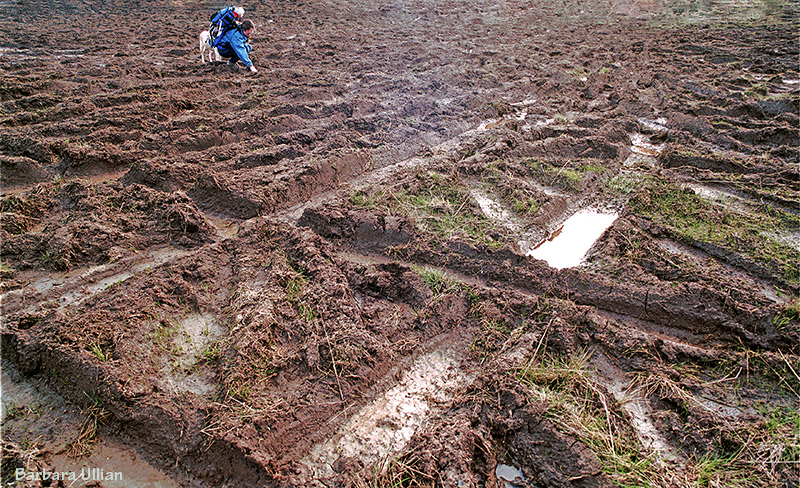
While the above photo shows the extreme, it can take a only a single track to permanently damage a wetland. Vehicle tire tracks can puncture the fragile clay pan layer that’s holding the spring water and many thousands of years of accumulated fine soils and nutrients. Puncturing the clay layer results in an alternation of the hydrology, a drying the wetlands or parts of them and death of the rare plants associated with them..
The other major threat to the wetlands and the unique floristically diverse serpentine terrain where they’re found, is strip mining of the ancient nickel laterite soils that have formed over thousands, if not millions, of years and this risk is increasing.

Five rare and endangered plants and the Serpentine Fen Conservation Agreement
Five rare plant species found in the serpentine Darlingtonia wetlands were initially proposed for protection under the Endangered Species Act. Instead of formally protecting them under the Act, the U.S. Fish and Wildlife Service developed a conservation agreement between the Rogue River-Siskiyou and Six Rivers National Forest and the Medford and Coos Bay Districts of the Bureau of Land Management. Read the conservation agreement here. The principle threat to the rare plans is any activity that alters the hydrological function of the wetlands, We’ve briefly discussed two above.
The five plant species subject to the Serpentine Fen Conservation Agreement are:
- Hastingsia bracteosa Wats. (large-flowered rush-lily)
- Hastingsia atropurpurea Becking (purple-flowered rush-lily)
- Gentiana setigera Gray (Mendocino gentian)
Epilobium oregunum Greene (Oregon willow-herb) - Viola primullfolia ssp. occidentalis (Gray) L.E. McKinney & R.J. Little (western bog violet)
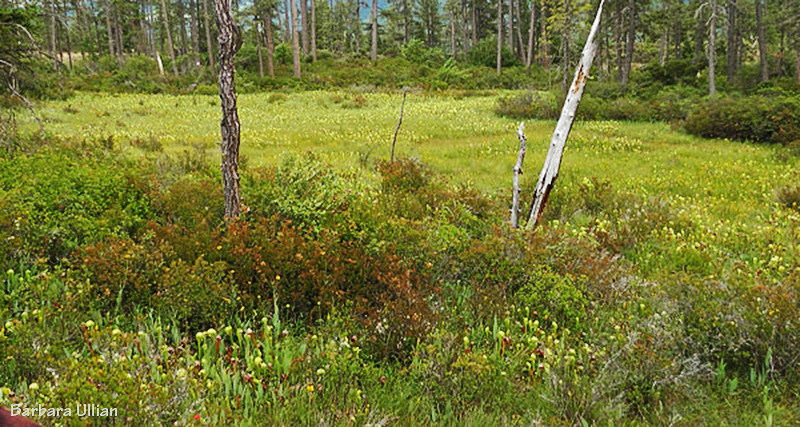
While signed in 2006 the land managing agencies have yet to fully comply with the terms of the conservation agreement. For example one requirement is to:
Develop and finalize a Conservation Strategy for Hastingsia bracteosa, H. atropurpurea, Epilobium oreganum, Viola primulifolia ssp. occidentalis, and Gentiana setigera and serpentine Darlingtonia fens and wetlands within an ecosystem context within the next three years. The Conservation Strategy would identify specific actions to protect the Darlingtonia wetlands from threats identified above.
The land managing agencies need an educated public to care about the serpentine lands and their special features, like the Serpentine Darlingtonia wetlands, wet meadows, serpentine barrens, and Jeffrey pine savannas. The Eight Dollar Mountain/Day Gulch Botanical areas and the Wild and Scenic Illinois River corridor is one of the best places to learn about them. Learn, protect, preserve and enjoy.

The National Wild and Scenic River Illinois River corridor and the river’s outstandingly remarkable botanical values
Immediately past the Eight Dollar Mountain boardwalk, on FS 4201 road, and enter the Siskiyou National Forest. The forest boundary marks the beginning of the National Wild and Scenic Illinois River that you’ll be driving along. A U.S. Forest Service trail runs along the river from the parking area at the BLM’s boardwalk to the Little Falls recreation site.
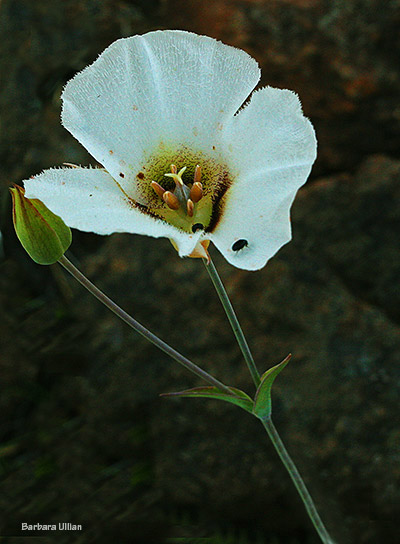
Cross over the river on what’s colloquially known as the “Green Bridge” and you’ll be in the Days Gulch Botanical Area. The top photo shows one expression of the floristically rich Jeffrey pine savannas that are found on the federal public lands on the west side of the Illinois River Valley.
Learn more about the unique serpentine landscape here and about Jeffrey pine savannas here.
One of the five outstandingly remarkable values recognized by Congress when it added 50.4 miles of the Oregon’s Illinois River to the National Wild and Scenic River System was the diversity of plant communities found along the river. This is especially evident as the river runs between the Eight Dollar Mountain and Days Gulch Botanical areas and the T.J. Howell Botanical Drive.
In The Little Falls Recreation site has a small amphitheater with a fire pit. A kiosk before you cross the Green Bridge provides information about the Wild and Scenic Illinois River. On the
The road is one of the Illinois Valley’s three gateways to the Kalmiopsis Wilderness and it’s also the T.J. Howell Botanical Drive (see below).
A hiking trail running along the Wild and Scenic Illinois River begins at the Darlingtonia boardwalk parking area. The trail ends at the Forest Service’s Little Falls Recreation site.
Eight Dollar Mountain is a mix of National Forest, BLM, State of Oregon and private land. The Nature Conservancy is one of the private land holder. On the north side of the conical shaped mountain is the Deer Creek Center, home of the Siskiyou Field Institute.
The T. J. Howell Botanical Drive
The Eight Dollar Mountain Road also provides access to the Babyfoot Lake Botanical Area and Kalmiopsis Rim Trailhead. The road itself has been designed the T. J. Howell Botanical Drive. To download the U.S. Forest Service’s map and interpretive guide to the T.J. Howell Drive click here . To read Botanist Linda Ann Vorobik’s blog post on the Babyfoot Lake Botanical Area and the area in general click here

Learn more about the Botanical Areas along Scenic River Area of the National Wild and Scenic Illinois River and the T. J. Howell Botanical Drive:
- Eight Dollar Mountain Botanical Area (USDA Forest Service , 2,738 acres).
- Eight Dollar Mountain Area of Critical Environmental Concern (BLM, 1,249 acres).
- Days Gulch Botanical Area (USDA Forest Service, 1,252 acres).
- Eight Dollar Mountain State Parkland (State of Oregon, 650 acres, about acquisition)
- Eight Dollar Mountain Preserve (The Nature Conservancy, 45 acres).
- The Siskiyou Field Institute and Deer Creek Center (a partnership between Southern Oregon University Foundation and the Siskiyou Field Institute).
- Eight Dollar Mountain, The Oregon Encyclopedia.
- The Forest Service admits “serious” mistake in logging botanical reserve, Seattle Times, August 24, 2005 – “The U.S. Forest Service admitted today to making a “serious” mistake that allowed 17 acres to be logged inside a rare tree reserve as part of the salvage harvest of timber burned by the 2003 Biscuit fire.”
- Rare Trees were logged by mistake Forest Service says, Spokane Spokesman Review, August 25, 2005.
- Serious Mistakes: Babyfoot Lake Botanical Area Backpack (2010)
- KS Wild – Babyfoot Lake Botanical Area (2016)
- About Western Azalea (Rhododendron occidentale)
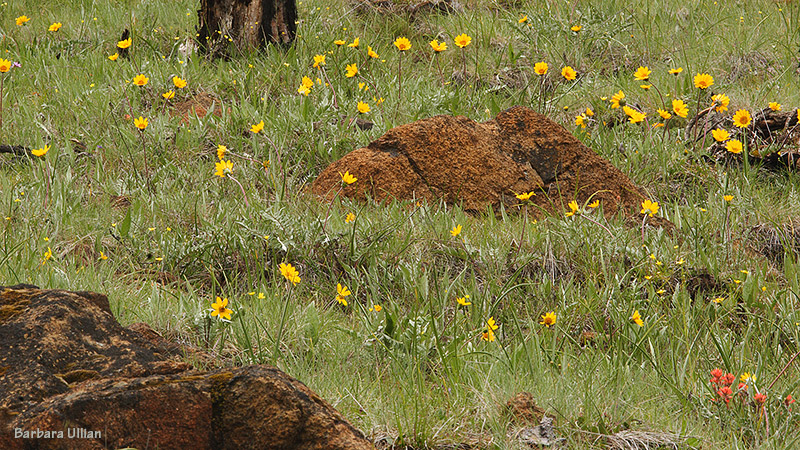
Vandalism, habitat damage and public safety
The Eight Dollar Mountain and Days Gulch Botanical Areas has experienced the greatest impacts. Pleas from the land management areas, signs and area and road closures are mostly ignored or vandalized. The land managing agencies have spent thousands of dollars installing vehicle barriers and fencing key areas.
This works if barriers are constantly monitored and maintained but it only addresses a few sites.
Newly installed signs at the Eight Dollar Mountain Boardwalk have been senselessly pushed over, with the posts broken off at the ground.
Off roaders have repeatedly churned a wet meadow in the Day’s Gulch Botanical Area to a sea of mud (pictured above). Forest Service botanists say most rare plant wetlands or wet meadows in the area have been impacted by off road vehicle users.
Public safety is a concern also.
Community leaders and businesses in Illinois Valley are trying to attract tourism but public safety concerns and the vandalism of facilities and lands detract visitors.
Forest Service and BLM offices responsible for these treasured public lands and for public safety are severely underfunded. They need our help and encouragement to address the problems.

Other threats
